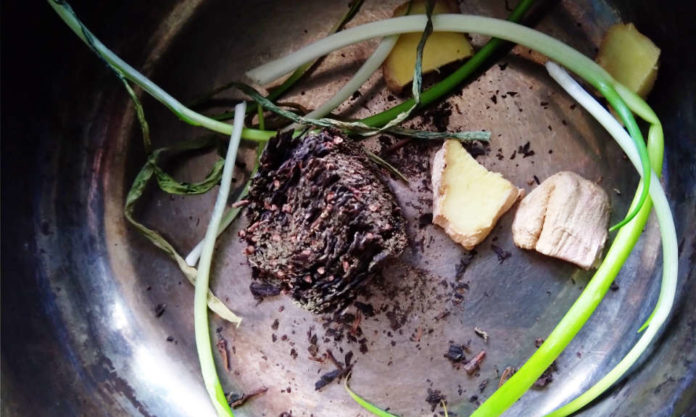They call it “herbal medicine”. And in this house, this week, it’s everywhere.
I call it “horrible medicine”. But I actually quite like it.
It smells of fragrant-soil and it tastes like fragrant-soil-with-brown-sugar.
Apparently, it has an English name; Isatis Tinctoria. But, like the names for all those things popular only in China, that’s not really an English name.
The brew hasn’t caught on elsewhere; what Americans call root-beer is a completely different thing. But here it’s enormous. As I write, your local pharmacy is selling fast out.
There’s no scientific evidence that this “Banlangen”
(板藍根) stuff can cure the mildest head cold, nevermind Covid-19. I have a friend who comes from its home town, Baiyunshan, Guangdong (广东白云山). Like me, he enjoys the drink’s aesthetics but doubts its efficacy. It’s very possible of course that we are both wrong.
Anyway, with vinegar and bleach on the walls and lock-down conditions imposed (by my wife), it’s a nice opportunity to try a decoction of my own, using my favourite plant, camellia sinensis. I’ve been planning to try this for a while.
- Apocalypse Tea; Should I Drive After Drinking This?
- Perfect Median; China’s Take on Earl Grey
- Swallowing is Just the Beginning; Rain, Flower, Cloud!
It is known that the origins of tea drinking were not infusion / steeping with hot water but instead continued boiling in heated water, just like Banlangen (the root version, not the “instant” granules). It is also known that ingredients such as onion and ginger were added to the tea drunk between the Zhou and Han Dynasties. But I’ve never actually tried making it before.
The tea I use for this experiment is a “dark tea” (黑茶), this time not Pu Er (普洱) but a variant from Hunan called Lin Xiang Black Tea (临湘黑茶). I bought it months ago as a brick in a box. Using our kitchen cleaver, I lop off a chunk of it into the saucepan. I add our last straggly spring onions/scallions and some slices of ginger. Hot water. Gas Flame. 10 minutes of it.
Quickly perceptible is a food-like aroma. If you tell a guest that it’s Meigancai (梅干菜) boiling in there, they’d believe you. That’s what it looks like, too. And, yes, it smells of dark tea; I’m reminded of a tea I used to buy in the UK called “Russian Caravan” with a sour, smoky taste supposedly augmented by camel sweat.
The “strainer” today is actually the kitchen sieve. And the liquid pouring through it is very dark indeed.
- Sugar-Free Bottled Tea; China’s Wu Tang Clan
- Which Tea Brand Best Compliments Your Private Jet?
- Happy Lemon; Drink it Like a Russian
There’s ginger in the cup’s aroma, but the “food” ingredients don’t really dominate when sipping. This tea is STRONG. Like hot coffee, it’s slightly oily and fills the mouth long after swallowing. That’s mostly the astringency. Probably it’s caffeine, too; online sources suggest that caffeine hangs on way past the 170 degree Celsius mark.
My wife manages barely a mouthful, describing it as “poison, not even medicine”’. The last cups I finish diluted with hot water. It’s a bit like my mum’s mutton gravy now, but not nearly as nice.
If taste is the goal, this one is going to require a few more iterations. Suddenly Banlangen seems enticing. But this is a longstanding itch I feel I’ve now scratched.
Actually, I was going to follow up this experiment with a “bullet-proof tea”. But, with my head slightly buzzing, I think I’ll leave that one for another day and another Strainer.









